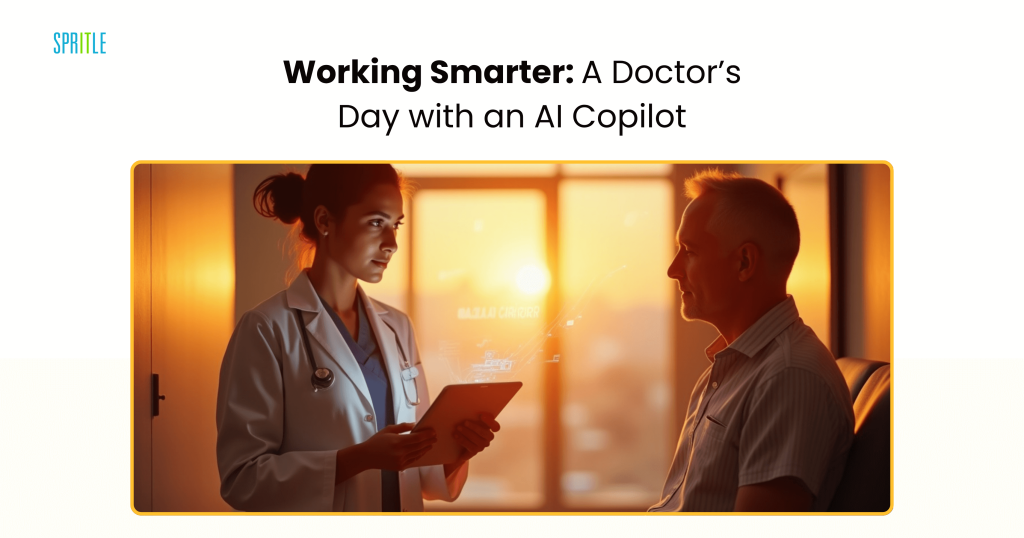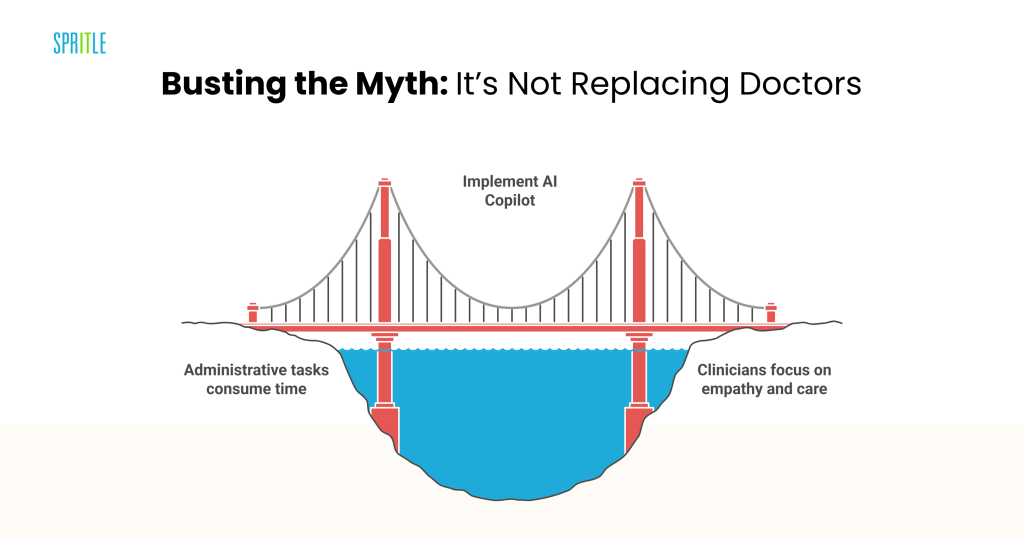
When Medicine Meets Machine, Humanity Wins
It’s 7:38 a.m. Dr. Maya Rao sips lukewarm coffee while glancing over her packed schedule: ten patients, two referrals, one returning case of chest discomfort. Before her first patient walks in, her AI Copilot has already flagged a patient trending toward early-stage hypertension and drafted key notes for the follow-up visit she’s about to begin.
Maya exhales. Not because her day is less busy, but because for the first time in years, she doesn’t feel like she’s doing it all alone.

Meet the Copilot: Smart, Silent, Always-On
The AI Copilot integrated into Dr. Rao’s workflow isn’t a robot with a voice. It doesn’t hover on a screen offering dramatic insights. It lives quietly in the background, working as a digital partner.
It scans patient histories, highlights potential risks based on patterns most humans might miss, and suggests next steps. It pulls prior lab work, connects the dots across EHRs, and gently nudges the physician: “Patient X has had a rising blood pressure trend for 18 months. Consider early intervention.”
It’s not magic. It’s memory, context, and logic—delivered without ego, fatigue, or bias.
Dr. Rao puts it simply: “It’s like a brilliant medical resident who never forgets anything, doesn’t get tired, and always keeps me focused on what matters most.“
And unlike human assistants, it scales. For every patient on her list, the Copilot runs background assessments, compares trends, and organizes details in real time—freeing Maya to do the one thing she trained her whole life for: care.
Then and Now: What’s Really Changed
Before the AI assistant, Maya’s mornings were a swirl of screen clicks and mental triage. By noon, she was running behind. By 3 p.m., she was mentally exhausted.
She recalls the feeling of being overwhelmed:
“You’re juggling patient stories, test results, and treatment plans in your head while clicking through ten tabs to find what you need. It’s not just exhausting—you’re always afraid you might miss something.”
Now, with her AI Copilot:
- She gets proactive alerts on patient risk trends.Notes are partially pre-drafted, ready for her review and personalization.Follow-up plans are automatically generated based on latest clinical guidelines.The EHR is no longer a battlefield—it’s a dashboard.
The biggest change? Maya spends more time talking to patients and less time typing about them.
Even short interactions have more depth. She’s not rushing. She’s connecting. That shift has changed the texture of her workdays—from frantic to focused.
The Human Moment That Made It Clear
It wasn’t the efficiency gains or the cleaner notes that sold her. It was a simple sentence from a long-time patient.
“Thank you for really listening today, Doc. I know you’re busy, but it felt like you had time for me.”
That sentence stuck.
It hit Maya that her AI assistant wasn’t just helping her do more. It was helping her be more present.
Present enough to notice a patient’s tone shift. Present enough to ask the extra question. Present enough to catch a symptom that might have gone unnoticed.
For Maya, AI didn’t just improve the pace of her day—it restored the purpose behind it.
And in the quiet moments between appointments, she found herself reflecting not on the weight of the work, but on the clarity it brought. Her sense of purpose sharpened. Her relationships with patients deepened. Even colleagues noticed a shift—not just in outcomes, but in her energy.
Busting the Myth: It’s Not Replacing Doctors
Let’s be clear. The AI Copilot isn’t making decisions. It isn’t diagnosing or prescribing. It’s guiding. Surfacing what matters. Freeing up mental space so Maya can focus on care, not clicks.
Think of it like autopilot on a plane: it doesn’t fly without a pilot, but it makes flying safer, smoother, and less stressful.
What it’s not:
- A chatbotA replacement for human judgmentA one-size-fits-all solution
What it is:
- A context-aware assistantA silent partner in prioritizing careA second set of eyes that never gets tired
More importantly, it’s adaptable. The Copilot learns with every patient interaction, fine-tunes its suggestions based on Maya’s preferences, and stays updated with evolving medical guidelines. It becomes more than a tool—it becomes an ally.
This evolution isn’t just technical—it’s cultural. It signals a return to medicine as a human-first profession. Where tools elevate clinicians, not distract them. Where technology dissolves into the background and empathy takes center stage.

The Bigger Picture: The Future of Care, Now
For many physicians, burnout is real. Admin overload is the number one cause. But what if we could fix that?
AI in healthcare isn’t about removing the human touch—it’s about restoring it.
When doctors have time to think, connect, and care, outcomes improve. Trust deepens. Patients feel safer.
And in Dr. Rao’s case, it shows. Her clinic’s satisfaction scores are up. Errors are down. She ends her day tired, yes, but fulfilled.
She even has time now to review cases at the end of the day—not just react in the moment. Her post-shift reflections are richer, more thoughtful. The ripple effect of the Copilot extends beyond the clinic walls.
“The AI doesn’t make me a better doctor. It just lets me be one.”
And that kind of fulfillment isn’t just good for doctors—it’s vital for patients, institutions, and the future of care itself. Because when healthcare providers are supported, everyone benefits. From quicker diagnostics to deeper human connection, the value multiplies.
Final Thoughts: This Isn’t Sci-Fi. It’s Real. And It’s Here.
We don’t need to imagine what the future of medicine could look like. We’re living it.
Doctors with AI copilots aren’t tech experiments. They’re your neighbors. Your care providers. The team you trust in moments that matter most.
And while the software runs quietly in the background, the impact is loud and clear:
- More time for patientsFewer missed detailsMore human momentsGreater job satisfaction for physiciansBetter clinical outcomes overallA culture that values connection over clicks
That’s what happens when you blend empathy with intelligence. That’s what happens when doctors have copilots.
The post A Day in the Life of a Doctor with an AI Copilot appeared first on Spritle software.

